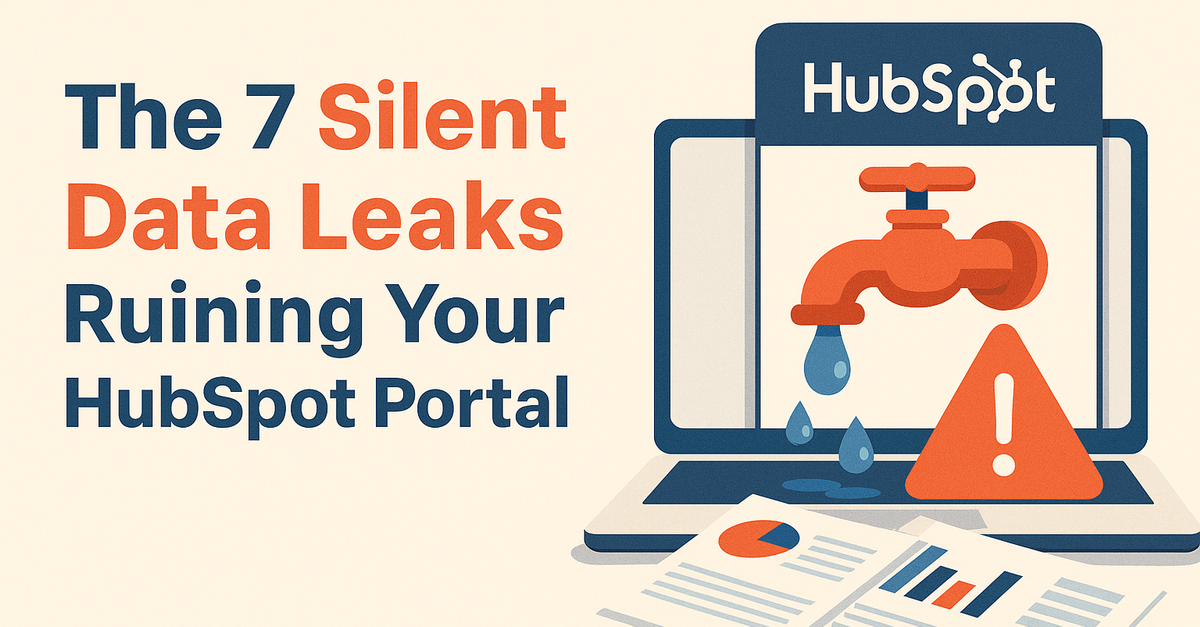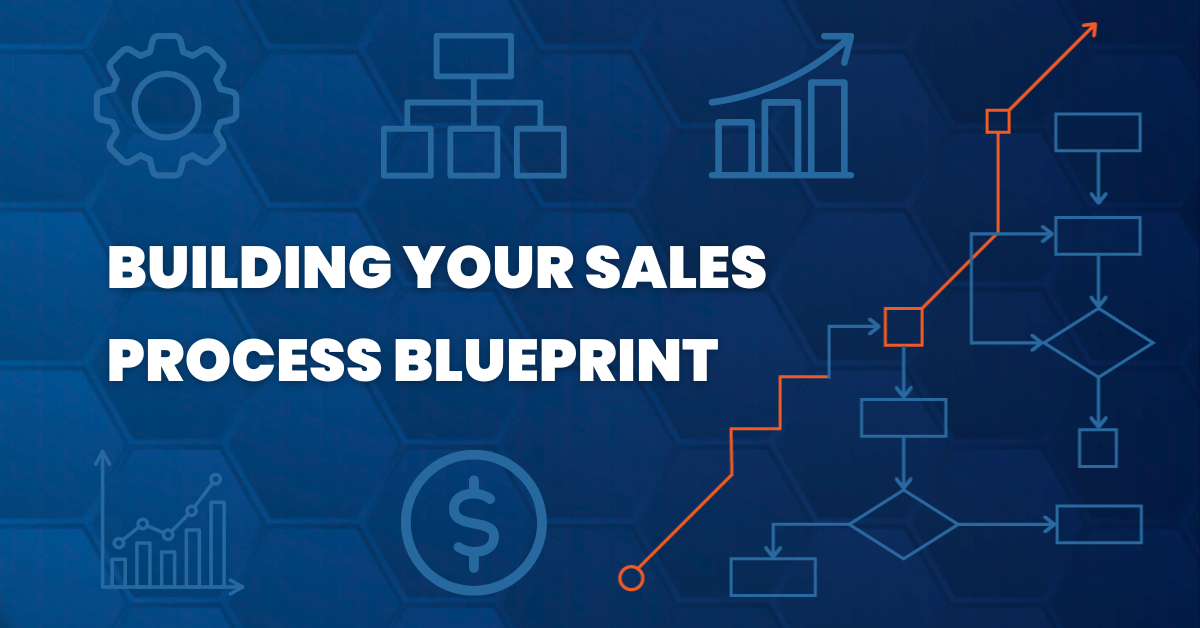The 7 Silent Data Leaks That a HubSpot Audit Can Fix for Better ROI
If your HubSpot reports have ever made you mutter, “that can’t be right,” this one’s for you.
4 min read
 Scotty Smith
:
Nov 13, 2025 11:15:41 AM
Scotty Smith
:
Nov 13, 2025 11:15:41 AM

If your HubSpot reports have ever made you mutter, “that can’t be right,” this one’s for you.
The truth is — most HubSpot portals don’t suddenly implode. They decay quietly over time.
The data gets a little messier each quarter, workflows pile up like old spaghetti code, and before long, your reports are lying to you with a straight face.
The scariest part? Everyone blames HubSpot.
It’s like blaming your car when you never change the oil. The problem isn’t the platform — it’s the build-up of unseen issues slowly leaking value from your system.
But any experienced HubSpot partner will tell you — a short HubSpot audit often exposes how fragile your HubSpot portal has quietly become.
Let’s plug those leaks.
It starts innocently — two records for the same person.
Then integrations, imports, and form fills pile on, and suddenly you’re looking at hundreds (or thousands) of duplicates.
If you’ve ever searched “how to clean up duplicate contacts in HubSpot,” you already know the pain.
Marketing thinks they’re nurturing 2,000 leads.
Sales thinks 1,200 of those are stale.
Reality: 900 are actually the same people twice.
Besides wasted send volume and jumbled activity timelines, duplicates wreck attribution and inflate your contact count — which, yes, means paying more for the same chaos.
A focused data audit inside your HubSpot portal quickly surfaces where those duplicates originated — old CSV exports, integrations, or manual entries — and gives you a clear plan for cleanup.
When’s the last time anyone reviewed your lifecycle stage definitions?
(If your answer is “what definitions?” — that’s the problem.)
Old leads sitting as “Marketing Qualified” from a 2021 trade show skew every funnel report. Executives make decisions based on a pipeline that doesn’t exist anymore.
Over time, every HubSpot team inherits outdated lifecycle definitions. Without routine HubSpot audits, these small misalignments cause entire marketing and sales reports to drift apart.
It’s one of the most common causes of HubSpot reports showing wrong numbers — the data looks healthy, but it’s years out of date.
Lifecycle stages should tell a story.
Right now, most portals are telling ghost stories.
An audit of your HubSpot data management can reset these definitions so reporting reflects today — not 2021.
You know that feeling when you edit a workflow and a mysterious automation undoes it 10 minutes later?
That’s legacy logic fighting back.
Every marketing manager and RevOps hire leaves behind a trail of “do not delete” workflows that now overlap. Some still update contact properties. Others auto-enroll every contact who sneezes.
Check your workflow audit logs or access history — you’ll probably see dozens of edits from former HubSpot users whose logic still runs today. That hidden account activity is often what breaks new automation.
Your CRM isn’t haunted — it’s just overdue for a HubSpot optimization audit. If your HubSpot workflows keep breaking or leads keep re-enrolling unexpectedly, that’s usually a signal that overlapping automations are quietly conflicting in the background.
Cleaning out “ghost workflows” can instantly improve automation accuracy and prevent future data corruption.
Somewhere in your portal is a list called “Q2 Webinar 2022 Attendees.”
It’s still being used as a filter in a report, workflow, or email send.
Lists age faster than avocados.
Many of those lists include outdated leads pulled from legacy CRM exports. A HubSpot cleanup aligns those lists with current segmentation rules and improves marketing accuracy.
If you’re not regularly pruning or rebuilding them, you’re sending campaigns to ghosts and wondering why engagement is dropping.
A HubSpot audit and cleanup catches these zombie lists before they skew your campaigns.
Marketing says, “We delivered 500 MQLs!”
Sales says, “We never saw them.”
You look in HubSpot and see a black hole of activity.
That missing account activity inside the CRM is one of the biggest issues we see during HubSpot audits — it quietly erodes trust between sales and marketing teams.
Calls, emails, and meetings that aren’t logged leave your reporting swiss-cheesed with gaps.
It’s not always laziness — sometimes it’s a sync issue or a workflow conflict — but the result is the same: leadership loses confidence in the data.
If your team doesn’t trust HubSpot sales activity reports, it’s time to audit your tracking and integrations.
That’s core HubSpot data management work — not finger-pointing.
Integrations can be sneaky.
One enrichment tool updates “Company Name” to title case. Another swaps your Lifecycle Stage.
You don’t see it happen, but the data erodes day by day.
It’s like having three roommates all editing the same spreadsheet. Eventually, someone overwrites column A, and no one knows whose version is right.
Every HubSpot integration — from enrichment tools to ad platforms — should be reviewed during an audit. Otherwise, conflicting data sources slowly rewrite your HubSpot data accuracy.
Audit your integrations. Document field ownership.
A solid HubSpot optimization plan keeps data from being overwritten and ensures every field has a clear “source of truth.”
At the end of the day, your reports are only as good as the data underneath them.
If your team doesn’t trust the numbers, they’ll start building “shadow spreadsheets” on the side.
That’s the ultimate sign your HubSpot ROI has sprung a leak.
Bad data doesn’t just make reports wrong — it makes people ignore them.
That’s when revenue alignment really falls apart.
The only way to uncover where those numbers went wrong is through a structured HubSpot audit. Reviewing audit logs of property and workflow changes reveals exactly when data started to drift.
A messy portal doesn’t mean HubSpot has failed you — it means your system’s due for maintenance.
Small to mid-market B2B companies run lean. Nobody has a full-time HubSpot mechanic.
But when your CRM is half truth and half fiction, every decision costs a little more, and every campaign performs a little worse.
Cleaning it up isn’t glamorous work — but it’s the kind of deep operational fix that makes everything else run smoother: better reporting, cleaner automation, higher sales efficiency, and more reliable marketing results.
A complete HubSpot optimization combines cleanup, CRM repair, and process auditing. When you partner with a certified HubSpot Partner agency like CycleWerx Marketing, your HubSpot account gets a full health check—data, workflows, integrations, and reporting.
That’s the work we love at CycleWerx Marketing.
We don’t do surface-level fixes.
We go under the hood, run a full HubSpot audit, clean out bad data, realign automation, and optimize performance — so your portal runs like it should have all along.
That kind of proactive HubSpot data management gives your sales and marketing teams confidence to scale without chaos.
If you’re tired of messy data and “off” reports, it might be time for a quick HubSpot audit and cleanup review. We’ll help you find the leaks, fix them, and get your HubSpot back to working like new.
Before you invest more time in patching problems, let’s confirm what’s really going on.
In a quick 10-minute “fit check” call, we’ll look at your portal together, spot the leaks, and see if a HubSpot Audit + Clean makes sense for you.
Subscribe to Our Monthly Newsletter
✅ HubSpot tips that drive action
✅ Marketing & sales strategies
✅ Insights for B2B SMB growth
Straight to your inbox.
No spam. No sales pitch. Just insights.

If your HubSpot reports have ever made you mutter, “that can’t be right,” this one’s for you.

The step-by-step blueprint small business owners can use to turn unpredictable sales into consistent revenue.

We're proud to announce that CycleWerx Marketing has officially reached HubSpot Gold Solutions Partner status.